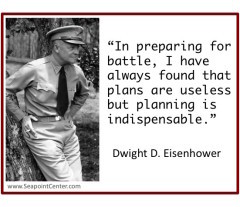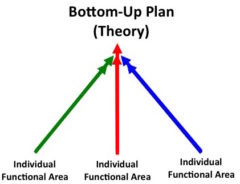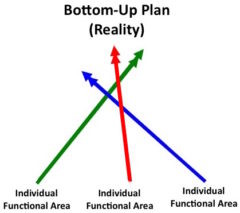 The traditional approach to strategic planning might be obsolete in this fast-paced, unpredictable world. But it does not mean that planning is useless. Creating a dynamic strategic plan will enable you to respond quickly and to be creatively proactive.
The traditional approach to strategic planning might be obsolete in this fast-paced, unpredictable world. But it does not mean that planning is useless. Creating a dynamic strategic plan will enable you to respond quickly and to be creatively proactive.
The problem with the traditional planning approach is – it doesn’t work. Recent research shows 60-80% of firms fail to execute their strategies, and fewer than 5% of employees are aware of, or understand their firms’ strategies.
The pace of change has changed. Technology has fundamentally disrupted the way we communicate and the way we do business.
Many leaders have adopted the military term VUCA (Volatile, Uncertain, Complex and Ambiguous) to describe the environment they are contending with. Dwight Eisenhower, familiar with a VUCA environment, understood there is a huge value to strategic planning if you do it right and if you understand how to use it.
A dynamic strategic plan will prepare you to make quick decisions when opportunities and challenges suddenly arise.
According to futurist Daniel Burrus, “a dynamic strategic plan has change built in to it, it’s in motion, and it provides a highly relevant and usable roadmap to everyone in the organization. A dynamic strategic plan evolves. It elicits dialogue and input from others. It can be continually refined and improved.”
In dynamic planning, the process of planning is as important as the plan itself.
There is tremendous value to taking time out for organizational reflection – intentionally stepping out of the day-to-day fray to consider the big picture.
And there is great value in thinking together simply for the sake of thinking together, rather than gathering for the purpose of creating a product (the plan).
- Organizational Intelligence: Through the process of thinking together, people become smarter about the business and the business environment, and set the stage to think strategically throughout the year.
- Organizational Communication: Because the entire organization participates in the conversation, it sets the stage for ongoing conversation throughout the year.
- Organizational Trust: Because people are seeking common understanding, not to prove they have the answer, trust increases and sets the stage for collaboration.
- Organizational Agility: Because there is alignment on the vision and values and a common understanding of strategic issues, people close to the action can be entrusted to make quick decisions without bureaucratic interference.
Five Guidelines for a Dynamic Strategic Plan
Although the steps in dynamic strategic planning are similar to the traditional approach, what looks like minor differences actually make all the difference. These guidelines highlight the differences.
1. Make it vision-driven.
The first, and most important, step is to ensure there is a clear, compelling vision that people understand and are committed to. This is the foundation for the rest of the work.
All strategic planning processes give lip-service to mission and/or vision. However, once that step is completed, it is often set aside, and the business analysis, goals and financials are only loosely related.
This is one of the reasons strategic plans fail so often. They’re not really strategic or connected to the real work.
The traditional top-down approach, where senior leaders go off to create a plan which is then delivered to the organization does not trickle down to a clear understanding of the vision or strategies to achieve it.
A bottom-up approach, where the planning starts with individual functional areas which are rolled up into an overall plan, is an attempt to solve the trickle-down problem. Because it involves everyone in the planning process, it theoretically builds understanding and engagement as you go.
In theory, the diagram looks like this: 
However, too often this approach is not driven by a clear, compelling vision. It is simply a roll up of individual ideas and the overall plan not cohesive or effective.
It’s like creating the blueprint for a house by designing each of the rooms and then fitting them together. Each room might be nice, but the house itself is non-functional.
And the theoretical diagram actually ends up looking like this: 
Vision is the glue. When the strategic planning process is vision-driven, there are many viable choices on how to proceed: top-down – or – bottom-up – or – cross-functional – or – whole company.
2. Get smart together through strategic analysis.
Almost every industry has been disrupted – from investing and banking to travel to entertainment. If your business hasn’t been disrupted yet, it will. If it has already been disrupted, it’s not over.
It’s important to get really smart together about the forces that currently impact or potentially could impact the enterprise.
Take the time to get good information, not just collecting opinions. In Real-Time Strategic Change, we call this “creating a common database of strategic information.”
Look at what’s happening with the economy, politics, technology, your industry, etc. And look internally at your current capabilities, management practices, culture, finances, etc.
Are you currently on track for fulfilling your mission and achieving your vision? What would happen if there were a shift in any of these external or internal factors?
Being vigilant and smart about potential impactful forces will help keep you from getting caught unaware by a sudden disruptive shift.
3. The questions are more important than the answers.
Asking “what if” questions, will help you be prepared to respond or even to leap over the next wave before it hits.
Coming up with great “what if” questions takes serious thought. You need to understand your industry, your business and potentially impactful forces.
Here are examples of though-provoking “what if” questions for healthcare leaders from Chris Cornue:
What if 50% of your volumes in any given service line were virtual?
What if more than half of your revenue came from channels that you don’t yet have?
What if more than half of primary care was provided through retail clinics?
As part of the planning process, identify the right “what if” questions for your company.
4. Identify “early warning signs” for the key strategies.
Once you’ve identified your key strategies (usually no more than three), build flexibility into your plan by identifying early warning signs that would tell you that strategy might need to be re-evaluated.
This is what makes your plan dynamic. The plan guides operational goals and decision-making, as long as the strategies make sense. A dynamic strategic plan helps you know when to re-evaluate and adjust your plans.
SNET made a strategic decision to divide their company into wholesale and retail. The wholesale side had been the cash cow, but it looked like products and services were going to be the biggest opportunity in the future. The wholesale side was a commodity, driven by price. They wanted the other side to be customer-focused and service oriented. By identifying early warning signs, they were able to adjust their offerings as they proceeded.
5. Create integrated goals to drive collaboration.
Goals are the bridge between plans and action. They describe what you will do, when, and create accountability.
When you create goals around your strategies, there is a role for each functional area. It is clear how the areas are interdependent and share responsibility for the success of the strategy.
For integrated goals, it can be useful to create a variation of the Agile RACI Chart for each goal to clarify roles, responsibilities, and communications needed.
Build into your goals how you will keep your strategic conversations alive, how you will identify your early warning signs, how you will adjust your goals if needed and when you might need to revisit your strategies.













Awesome post! Thanks JLS.
Thank you, Gana. Glad you appreciated it.
A very wise post , Jesse, and applies to our personal lives as well.
Thanks and happy new year. MG
Thanks for pointing out this applies to individuals also, and for your good wishes, MG.
Very interesting post Jesse.
We have recently revamped our strategic planning for the company I work for and it feels good to know that we are in line with your advices in this post 🙂
Thank you for such a valuable post. I’ll share it with my colleagues now.
Regards,
Khalid
Delighted to hear that, Khalid. It’s good to hear from people who are doing it right. It shows that it’s possible for other leaders.
I love the ideas and concepts you present here with this post, Jesse. I’m bookmarking it to re-read with the intent to capture these ideas for sharing with my Coaching clients. I’m a big fan of Strategic Planning and have helped organizations conduct planning retreats. Thanks for sharing such valuable content. (I’m stealin’ it……with your permission, of course.)
Thanks, Dan. Yes, please use it. The point is to help leaders create plans that will help them navigate these murky waters. Otherwise, they will join the ranks of the 80% who fail to execute on their strategies.
Great information and relevant to how most executives feel about time and relevance – you really have your finger on the pulse Jesse!
Thanks, Mary! We need to adjust the process so it is relevant in today’s world. As you know, when leaders don’t see the value of taking time out for reflection and strategic planning, it perpetuates a short-term crisis-management approach to leadership.
Hi Jesse, thanks for writing the blog. I friend of mine is ex military and he introduced me to the idea about a plan and planning. I too have captured a few thoughts from your blog to use in the future. The vision piece is absolutely critical and yet so many fail to articulate it in a meaningful form.
Thanks, Phil. So glad to hear you found this useful. And I agree that too many “fail to articulate vision in a meaningful form.” If you haven’t read this, you might appreciate my summary of the 3 elements of a compelling vision.
Thanks for this post, Jesse, Your references to VUCA and to Eisenhower reminded me of a related approach to strategy and action. One that Ike almost certainly knew about. That is John Boyd’s OODA Loops. Developed by Boyd in response to the experience of flying in combat during the Korean conflict, Boyd suggested iterated loops to O-Observe; O-Orient; D-Decide; and A-Act. Very much in line with your suggestions. The Wikipedia piece on this is at:
https://en.m.wikipedia.org/wiki/OODA_loop
Have a wonderful New Year!
Excellent reference, Bruce. Thanks for sharing it. You remind me that even though the pace of change in today’s world can make it feel like everything is different and all the rules have changed, there is timeless wisdom that shows us how to participate proactively and intelligently instead being reactive and overwhelmed by fear of the unknown.
Excellent Jesse the idea is very useful. i am university student, but this article open my mind on how to successful run a business. Keep posting this article and just say well done.
I really appreciate your feedback, Daniel. Good luck with your studies.
This article provides some great insights into creating a dynamic strategic plan. I appreciate the emphasis on adaptability in today’s fast-paced environment!
Thank you, Mario. I’m glad you found it helpful.